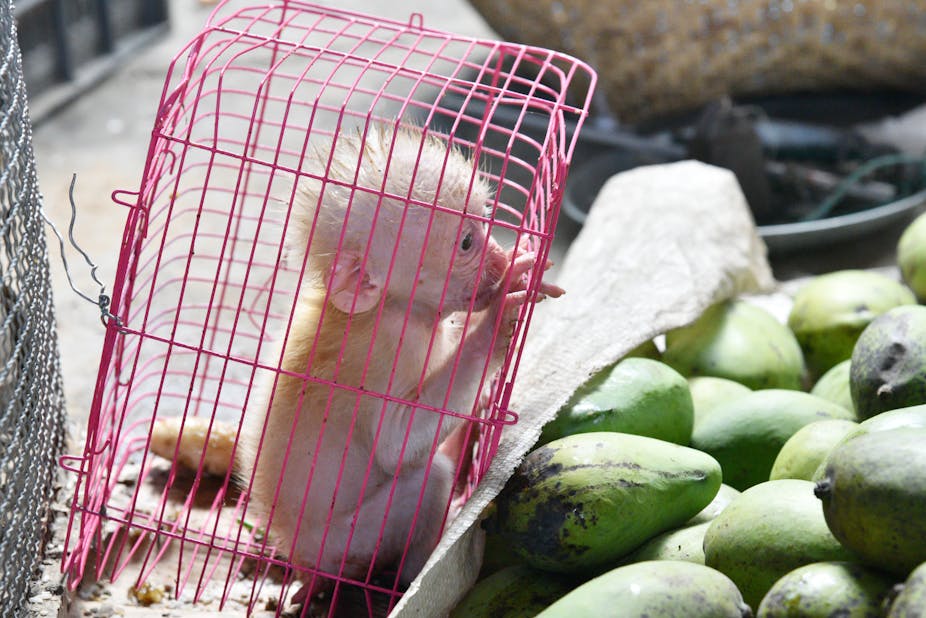The legal global wildlife trade is worth roughly $300 billion. Of more than 31,500 listed terrestrial birds, mammals, amphibians and reptiles, approximately 5,500 are traded. Research predicts that a further 3,196 species may be traded in the future, placing a possible 8,775 species at risk of extinction.
Serious attempts to regulate the trade in wildlife and plants began in 1973. And in 1975 the Convention on International Trade in Endangered species of Wild Fauna and Flora came into force. It now boasts a membership of 183 parties.
A great deal of controversy surrounds the purpose and efficacy of the convention. But its original text recognises that:
Wild fauna and flora in their many beautiful and varied forms are an irreplaceable part of the natural systems of the earth which must be protected for this and the generations to come.
With many species now at risk of extinction, questions are being raised about the sustainability of the global wildlife trade and whether it can be reliably regulated or not.
The convention works on a listing system. Appendix I prohibits trade in species classified as highly endangered, whereas Appendix II allows trade under very specific conditions. The system is full of loopholes though, as trading countries often ignore basic checks and balances such as verifying the authenticity of an import destination listed on an export permit. This allows the proliferation of illegal trade.
Read more: Explainer: what is CITES and why should we care?
Illegal trade is estimated to be worth between $7 billion and $23 billion annually. Given the sheer scale of this problem, the convention cannot combat it alone.
But calls to end the global wildlife trade have been growing in the wake of the COVID-19 pandemic. The reason is that the SARS-CoV-2 virus most likely infected humans at a wet meat market in Wuhan, China, in November 2019.
These markets, where live animals are sold and slaughtered, are an integral component of the global wildlife trade.
Thirteen years ago the world was warned about the risks of zoonotic spillover – the transmission of disease from animals to humans – which may tip the scales in favour of bans. But the warnings went unheeded. And the debate about whether the wildlife trade should be banned has remained as intractable as ever.
The arguments
A group of Oxford scholars has cautioned against hasty bans:
Blanket bans are unlikely to benefit people or wildlife and are unfeasible because they overlook the complexity of the wildlife trade. The COVID-19 outbreak should not be used opportunistically to prescribe global wildlife trade policy. A more appropriate response would be to improve wildlife trade regulation with a direct focus on human health.
Economists tend to oppose bans because they can drive legal trade underground. The anti-prohibition argument typically presupposes the economics of alcohol and narcotics, though.
But, in my view there’s a big difference – alcohol and narcotics are renewable resources with physiologically addictive properties. Demand is often relatively insensitive to changes in price and supply is widely available.
Read more: Captive lion breeding in South Africa: the case for a total ban
Wildlife entails a different set of economic dynamics. Wild animals are not renewable. Nor is the consumption of their meat, horns, scales, bladders, tusks, teeth, bones, claws and paws physiologically addictive. In addition, they play an integral role in their ecosystems.
Read more: Game theory suggests China should keep its ivory trade ban in place indefinitely
The counterargument is that bans may fail to stigmatise consumption where demand is driven by social desirability. But this overlooks the fact that cultural preferences are dynamic. There’s evidence of appropriate preference shifts in response to knowledge of ecologically destructive practices.
Elephant ivory is a good example. Chinese authorities promoted its consumption as a public heritage good in 2008 when China bought stockpiled ivory from African countries. Seven years later, it announced a domestic ivory trade ban, recognising that ivory consumption was incompatible with an “ecological civilisation”. It had the desired effect: a large proportion of consumers who were indifferent to ivory consumption prior to the ban indicated that they would no longer purchase it.
There’s also an argument that bans on trading a particular animal or its parts will drive up prices in response to perceptions of scarcity. But this isn’t necessarily so. The price of raw ivory plummeted between 2014 ($2,100/kg) and 2017 (to $700/kg). This was likely in response to the Chinese ban.
Moreover, legal trade often has no ability to crowd out illegal activity. Instead, in a corrupt world, it can create laundering opportunities for illegal supply.
The economics are simple: illegal product is always cheaper to procure.
Another concern about a trade ban is articulated by proponents of “sustainable use” who worry about the impact it would have on “wildlife economies”. Wildlife breeding in China alone is estimated to be worth $74 billion and involve 14 million people.
But wildlife economies are behind the current global economic collapse – one that’s projected to cost anywhere between $2 trillion and $4.1 trillion.
Bans beat reform in some cases
Is the answer better regulation?
Probably not. Every type of improvement in regulation requires more law enforcement capacity, technology and manpower. These don’t exist in many contexts.
Yes, bans have to be congruent with local norms to be effective, but it appears easier to shift local norms than to improve regulation. The transaction costs of policing bans are likely lower than the transaction costs of policing improved regulations. Differentiating between legal and illegal products at ports, for instance, requires extensive training and resources.
Past efforts at improving regulations have failed. Bans may be a knee-jerk reaction, but they likely beat the call for improved regulation. Fine-tuning ineffective regulation will not prevent the destruction of wild habitats and their inhabitants.
What’s clear is that we can’t continue to use nature as if it’s free capital. Ecological systems are at breaking point and economic collapse is currently under way.

